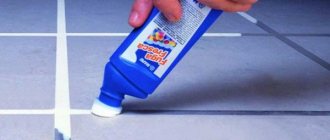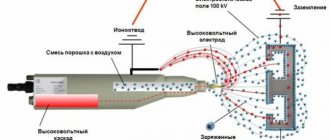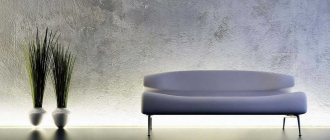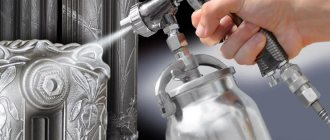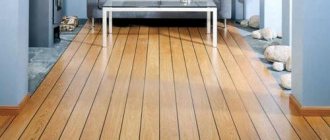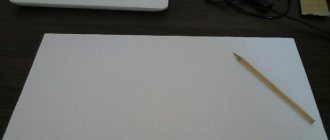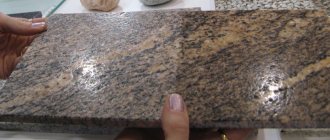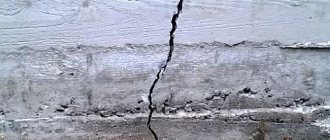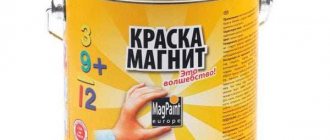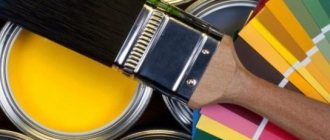Painting is a universal way to give walls, ceilings and flooring an attractive look and additional protection from environmental influences. It is also noteworthy that this finishing method will not require significant costs or special skills from you. In addition, if you are already tired of classic monochromatic cladding, paint with a cracked effect will be a pleasant discovery for you, which can give your interior unique originality and aesthetics.
In this article we will analyze the features of this type of finishing solution and the stages of applying it yourself.
Photo of a wall treated with paint with a crack effect
general information
The use of paints and varnishes with a cracking effect can transform any surface. After processing, the material acquires its original appearance: the surface appears to be covered with cracks (craquelure effect). Moreover, the size of the cracks, as well as the tonality of the surface, can be controlled. The cracking effect occurs due to the fact that the top layer of paint dries faster than the bottom layer and lacks elasticity.
Among the types of paints, acrylic compositions are considered the best choice, since they have many advantages:
- aesthetics;
- environmental friendliness and safety;
- affordability;
- vapor permeability (allows the surface to “breathe”);
- high-quality concealment of defects in the base material;
- waterproofing properties (good for wet rooms);
- wide selection of colors;
- ease of use.
For metal surfaces it is recommended to use special compounds:
- “Zinga” paint (special electrically conductive composition with anti-corrosion properties);
- fire retardant paint "Polistil".
General description of material parameters
Craquelure paint will give a unique look to any surface. The network of cracks forms unique patterns. You can control the depth and intensity of the effect, which makes it possible to transform any foundation. This cracking occurs due to the low-elasticity of the second layer of dye, which is faster than the bottom layer in terms of drying speed.
The most in demand are acrylic compositions with a crack effect. This is largely due to their inherent properties:
- acceptable price;
- maintaining a comfortable microclimate due to excellent vapor permeability;
- protection from the negative effects of moisture;
- ease of use;
- huge selection of shades;
- the ability to qualitatively mask base defects;
- safety and environmental friendliness;
- excellent decorative properties.
Special fire-retardant (Polistil) and anti-corrosion compounds (Zinga) have been developed for processing metal products.
Effects and types of craquelure
Using craquelure, you can give the surface a wide variety of effects, including:
- wild stone;
- flowing sand;
- water flow;
- drops of water on glass;
- tree bark;
- porous skin;
- fabrics made from natural materials;
- velvet;
- pearl;
- marble;
- porcelain.
The choice of a specific type of craquelure paint depends on the effect you want to achieve:
- A rustic style is created through the use of one-step varnish. The cracks look as if they appeared a long time ago.
- The classic style surface shows deep, distinct and frequently spaced cracks. The style is often used for the background of large-scale decoupage works.
- The type of wood allows the surface to look as if it were tree bark. The cracks are deep and spaced very often.
- The painterly style features many delicate, fine cracks. The surface itself looks beautiful, and in addition, this style makes it possible to qualitatively age small objects.
- Ceramic finishes are often used to age tableware.
These are just a few of the existing craquelure techniques. If you wish, you can use other techniques or create your own.
Advantages and disadvantages
Decorative craquelure plaster has both advantages and disadvantages. We cannot move on without mentioning them, because we must know what we are dealing with.
Advantages:
Originality. Decorative materials are already original in themselves, but craquelure stands out even among them. The walls will truly be original and unlike anything else that can be done with any other decorative plaster. Moreover, with the same material you cannot create two identical surfaces, because cracks always appear randomly. So there will definitely not be identical drawings.- Wide choice of surfaces. Be it plaster, concrete, plaster, brick, cardboard or other materials, craquelure can be successfully applied to everything.
- Moisture resistance, which prevents the appearance or development of mold and mildew.
- The durability of the created coating is another advantage.
- The environmentally friendly material does not contain any harmful components, which makes it extremely safe. Also, when working with decorative materials, no harmful substances are released.
- Variability of coverage. If the created cracking effect is not enough, then you can paint everything with paint or varnish. You always have the opportunity to enhance the effect of cracks if it seems to be weak.
You cannot remain silent and not talk about the shortcomings. Although there are not many of them, they should also be mentioned in order to have the complete picture before your eyes.
Flaws:
- Difficult to apply. Decorative craquelure plaster is really difficult to work with, at least at first. To create a truly beautiful crack effect, you will have to practice a lot or hire a professional. Although you can try it yourself, you may not be pleased with the result.
- High price. The point is not so much the high cost of the material, but the price of the services for its application. Since a very original drawing is being created, the work will not be cheap.
Painting technology
Preparatory work
Before you start painting, you need to carry out preparatory measures. The task is to ensure that the surface acquires maximum properties that will allow the paint and varnish material to adhere well to it.
Note! The usual preparation is to remove old paint. This stage can be bypassed experimentally if the coating is strong enough and does not cause concern. A little paint is applied to the old surface and, if the effect is satisfactory, you can continue painting the entire product.
Work order:
- Remove old paint layer. This is done with a scraper after treating the surface with an industrial hairdryer (a special remover is also suitable). If you need to remove wallpaper or a layer of plaster, use a roller soaked in water, and then a sharp spatula. To remove tiles or a thick layer of plaster, use a hammer drill or a more labor-intensive method - a hammer and chisel.
- Remove any accumulated debris.
- Repair defects and cracks (if any). To do this, use sickle tape and putty.
- Sand the surface, removing even small irregularities.
- Check the evenness of the surface using a building level.
- Apply primer. This is an important step, since the primer ensures good adhesion (adhesion) of dissimilar materials.
- When the surface is completely dry, perform the last step before applying craquelure to the wall - sand the base.
Painting
The work is performed in the following order:
- Mix the contents of the jar with the paint and varnish composition. Then pour the mixture into an open container specially designated for work. It is advisable that the tray have a corrugated surface - this will allow you to conveniently remove excess paint from a brush or roller. Hard-to-reach areas of the surface are painted with a brush. It is most convenient to treat wide surfaces with a foam roller.
- Wait for the first layer to dry. Open the second can of paint and apply the contents to the previously painted surface. After some time, the surface will begin to crack as planned.
- After the cracking process is complete, it is advisable to coat the surface with varnish. This will improve the protective properties of the coating.
Secrets of quality painting
The coating will be of better quality if you adhere to a number of recommendations outlined below:
- The first layer dries faster after treatment with a hair dryer.
- The quantity and quality of craquelure is controlled by varying the thickness of the finishing coating. If you add water to the composition, the paintwork will become thinner, and the cracks will be rarer and thicker.
- The width of the craquelure can be reduced by processing the surface several times.
- The direction of the drawing is changed using certain tools. A roller or paint sprayer will help ensure uniformity of the coating and natural cracking. A wide and flat brush creates a compact craquelure. Moving the brush vertically and horizontally will help create a cage-like pattern.
- Small areas can be filled with paint using your finger.
Craquelure techniques. One-step, two-step and others.
Crackle –
an artificial aging technique based on creating cracks in the paint layer. It is widely used both independently and in combination with decoupage or other techniques.
Craquelures are divided into one-step (single-phase) and two-step (two-phase)
One-step craquelure is considered easier to perform. Two-step craquelure is more finicky, but also more beautiful, and also does not overlap the primary image or background, which allows it to be used both on gold and on a printed image.
Craquelure varnish production is based on high-quality imported gum arabic (has a very high surface tension). You can use it as a one-step or as a two-step paired with shellac alcohol varnish.
One-step craquelure looks like a cracked layer of paint, through the cracks of which the lower layer of paint or the base of the product is visible. For example, glass or metal.
Work progress:
1. Apply a layer of paint to the surface, which will be visible through future cracks. It can be any color, for example, metallic shades, gold, silver, bronze and other metallics look very beautiful. If your idea is to show the color of the base, then you can leave it uncoated. As, for example, when working with glass.
2. After the first layer of paint has dried, a fairly thick layer of craquelure varnish is applied to it. Leave for about forty minutes until almost completely dry. You can speed up its drying a little with a hairdryer. The varnish should look dry, but be slightly damp when it touches your hand.
3. For the second layer, acrylic paints are suitable, such as the “Acrylic-Art”, “Acrylic-Hobby”, “Acrylic-Hobby De Luxe” series or painting paint. Before application, the paint should be diluted with water. The thinner the paint, the larger the cracks will be. If small cracks are needed, then it is recommended to dilute the paint with acrylic paint thinner or acrylic varnish. Thick paint will be very difficult to apply in one go. It is best to apply the finished paint with a wide synthetic brush. The direction of the cracks will coincide with the direction of movement of the brush.
The most important thing: you can only brush one place once.
Otherwise, the varnish may begin to “roll off.”
4. You can speed up the drying of the second layer a little with a hairdryer. The top layer of paint begins to crack quite quickly. After drying, a day later, the paint layer must be fixed. You can fix it with shellac, acrylic, or acrylic-pistachio varnish.
Scheme for using craquelure varnish as a one-step method:
Two-step craquelure looks like a network of thin cracks, cracked varnish, on the surface of any image (for example, on top of decoupage or painting) or a plain coating of any shade.
Thank you for reading our articles! We are giving you a promotional code BLOG for a 15% discount in our online store
. Enter it in the “enter coupon” field when placing your order.
Progress:
1. To create a two-step craquelure, the first layer is applied with shellac varnish (the classic principle of creating a two-step craquelure: shellac + composition based on gum arabic, craquelure varnish). You can use both clarified and unclarified. Unbleached varnish will give the product a slight patina.
Shellac varnish is applied in 2-3 layers, allowing each layer to dry completely. Alcohol varnish dries quickly, from 15 to 30 minutes. Depends on air humidity.
2. After the shellac varnish has completely dried, a layer of craquelure varnish is applied to it. The main criterion that affects the rate of crack creation will be air humidity, not temperature. In a warm, dry room the process will be more intense. With two-step craquelure, it is better not to speed up the process with a hairdryer, but to place the product next to a radiator, in the sun, or in a warm and dry place.
3. After noticeable cracks appear on the surface, they are rubbed over. To do this, use artistic oil paint, grated pastel, eye shadow or bitumen varnish. This process is best done with a sponge or natural cloth.
4. After drying, seal with shellac varnish. Thus, it turns out that the consumption of craquelure varnish in relation to shellac varnish will be 1:3.
This technique can easily add a touch of noble antiquity to almost anyone and stylistically diversify your work.
Scheme for using craquelure varnish as a two-step method:
Video tutorial describing the creation of one-step and two-step craquelure:
Video from YouTube
Eggshell crackle
Another type of decorative technique for aging surfaces using natural materials is eggshells. It can be used to decorate objects with a craquelure effect.
To do this, you need to collect and prepare eggshells for work. Wash the chicken egg shell with a brush and detergent in warm water. Then peel the shell from the inner film and dry.
After the eggshell has dried, it should be glued onto the previously primed surface of the product. To do this, I generously coat the application area with PVA glue or acrylic varnish. And after that, parts of the shell are laid out at a short distance from each other. A large piece of shell can be pressed down with your finger and it will split into several small pieces, which can then be conveniently pulled apart with a toothpick or bamboo skewer.
After the entire surface is filled with shell pieces, leave to dry. Next comes painting the decorated surface of the product with acrylic paint. If desired, you can erase the gaps between the glued pieces of eggshell with oil paint or pastel, as in the two-phase craquelure technique.
Faceted varnish
A decorative product for creating cracks, giving the product an “antique” look. Facet varnish adheres well to all absorbent surfaces, such as wood, ceramics, cardboard. Glass and plastic surfaces must be pre-treated with primer or glossy varnish.
Facet varnish is quite thick (like a paste) and is applied to the surface using a spatula, modeling knife, palette knife, hard brush or sponge. The varnish layer must be at least 2 mm. Distribute evenly over the surface. The size of the cracks depends on the thickness of the applied layer. Drying time depends on the surface and thickness of the layer, the period is about 24 hours.
Microcraquelure two-component
Two-component system of craquelure varnishes for creating microcracks on the surface. The result is the effect of a thin cobweb. Step 1:
Apply a special transparent primer to the prepared or decorated surface and wait until it dries completely.
Step 2:
apply craquelure composition. The depth, thickness and direction of cracks depend on the direction of movement of the brush and the thickness of the applied layer of varnish. After drying, the cracks can be emphasized with antique paste, pigment, liquid patina, or oil paints. Formed cracks ranging in size from 1 mm. Microcraquelure varnishes have no color. The shade of the decorated surface does not change, but only acquires the effect of an aged and cracked surface.
Also suitable for pre-decorated objects and surfaces with any pattern and application, for glass. After drying it becomes waterproof. We recommend covering the work with a finishing varnish.
Craquelure paint
Easy to use, one-step paint creates a craquelure effect when dry.
Colored. It is applied with a brush to the surface of the product and after some time the paint cracks, forming a beautiful network of cracks. Buy paints, varnishes and other goods for painting and creativity with the promotional code BLOG for a 15% discount in our online store
. Enter it in the “enter coupon” field when placing your order.
One-component craquelure technology
The main requirement that must be met in order to achieve high quality coatings is stable temperature conditions and normal humidity levels. Drafts should be avoided.
Since this type of coloring requires a certain skill, it is worth practicing first on a piece of unnecessary material. Dense plywood a few millimeters thick will do. Before painting, the material must be primed and dried.
Paint (preferably acrylic) is applied using a roller. To get light cracks, use cream, blue, beige or silver colors. Azure gives a metallic or pearlescent tint. The paint should be applied in a thin layer - evenly, avoiding smudges and too abundant strokes. On average, the coating dries in 4–6 hours (the time depends on the air temperature and humidity in the room).
The second layer is applied with a one-component craquelure varnish. If the varnish is spread over the surface with a roller with uniform horizontal or vertical movements, then cracking will correspond to the direction of varnishing. A more varied pattern is obtained by performing alternating brush movements in different directions. The depth of the cracks is controlled by changing the thickness of the paint: the more paint composition, the deeper the cracks.
Venetian or structural plaster is applied to the dried coating. To do this, use a wide spatula. Movements should be smooth, tangential, and not pressing. The nature of the movements can be either chaotic or schematic, depending on the creative concept. If structural plaster was used, the surface must be sanded.
Plaster can be replaced with acrylic paint. It is advisable that the paint contrasts with the base. Decorative varnish or natural wax is applied to the painted surface.
Note! Since cracks appear within 7-10 minutes, you need to paint quickly.
Other options for creating cracks
There are several techniques for performing craquelure coating. Depending on the method chosen, the pattern will differ.
Application of two-component varnish
This technique is more complex and will require more time, since an additional step of work is added. For this, craquelure and simple varnish are used. The essence of the method is as follows:
- The previously prepared surface is covered with a layer of decorative enamel. Dry and repeat the process.
- Cover with craquelure varnish, avoiding smudges. Allow to dry for at least 60 minutes.
- Apply the next layer. In total, you can coat several times, as a result of which the cracks will become deeper. It is not recommended to apply more than four layers.
- Cover with a layer of plaster and allow to dry. Level with sandpaper.
Finally, wax is applied twice, with a half-hour break. Allow 24 hours to dry.
Mechanized application
To mechanize the work, you can use a spray gun. With this method, the varnish should be diluted with water in a ratio of 9:1, respectively. It is worth paying attention to the following nuances:
- In order to avoid the formation of clots, the varnish mixture is sprayed onto the sampler. Once uniform distribution is achieved, you can begin processing the walls.
- Do not interrupt during the application process - this can lead to staining and uneven coverage.
- Upon completion, the spray gun must be moved to the side, and only then turned off.
In order for the mixture to be distributed evenly, during operation it is necessary to maintain the same distance between the nozzles and the wall.
Craquelure effect on wall surfaces
There are also textured plasters on the market that have a craquelure effect. This technology is quite complex and requires speed and dexterity. Therefore, it is more convenient to do the coating together. To do this proceed as follows:
- Carefully level and prime the surface.
- Apply the plaster composition and level it with sandpaper.
- To dry the layer faster, use a hairdryer or fan so that the air enters at an angle of 45 degrees. If you do not use a hairdryer, the surface will dry out slowly and the desired craquelure effect will not be achieved. It largely depends on the air temperature at which the drying process occurs.
- Wait for the craquelure to form. This happens up to approximately 1 hour.
- Once cracks have formed, the blowing is completed.
The coating needs to dry well, so it is recommended to apply protective varnish or wax no earlier than every other day.
For additional decoration, cracks are tinted, covered with colored varnish or wax. It is carefully rubbed into all the recesses, and the excess is carefully removed with a dry sponge.
Application of two-component varnish
This coloring option is difficult to perform, but gives an excellent external effect. The prepared base is painted in the desired color and then dried. After this, a layer of craquelure varnish is applied. Apply the varnish in a very thin, even layer. As soon as the coating becomes hard and transparent, a second layer of paint is applied. After the second layer has dried, a finishing coat (paint) or plaster is applied.
Note! Because the paint material dries so quickly, it can stick to the brush, disrupting the correct texture. To prevent such developments, the finishing layer must be applied as quickly as possible (plaster - within 5 minutes, paint - no more than a minute later).
When the coating is completely dry, begin grouting. To do this, use dark oil compositions, dry pastels or gold powder. The substance is impregnated with a sponge, which is used to treat the surface. Excess material is removed with a cloth soaked in vegetable oil. The final stage is wiping the coating with a dry, clean cloth. It is advisable to fix the texture with a finishing layer of transparent varnish.
In order for the surface to maintain its attractive appearance, it requires care. Craquelure is easy to deform and is unstable to mechanical stress. This coating is afraid of excessive moisture. It can only be washed with abrasives or special chemicals. Wet cleaning is acceptable, but it should be done no more than once a week.
How to care
In order for the coating to last for a long time, special care is required: do not wet it excessively, only wash it with abrasive agents and clean it with special chemicals. Carry out wet cleaning once a week with a soft cloth.
Craquelure is a fragile coating, it can be damaged by a blow or when rearranging furniture; only a master can restore it unnoticed.
Craquelure looks impressive and gives a special atmosphere to the room. With proper application and care, the coating will last a long time and with high quality.
